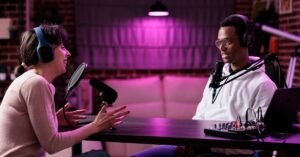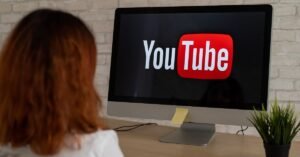In the world of digital content creation, podcasting and YouTube stand out as two of the most popular platforms for sharing stories, expertise, and entertainment. While both podcasters and YouTubers aim to connect with audiences, their methods, tools, and creative demands differ significantly.
Whether you’re an aspiring creator deciding which path to pursue or a curious fan wanting to understand these mediums, this article explores what makes a podcaster different from a youtuber, diving into their workflows, audience dynamics, and unique challenges.
What Is a Podcaster?

A podcaster creates audio content, typically released as episodes on platforms like Spotify, Apple Podcasts, or Google Podcasts. Podcasts cover a vast range of topics—think true crime, self-help, history, or casual chats with guests.
The audio-only format allows listeners to tune in while multitasking, whether they’re driving, working out, or cooking. Podcasters rely on their voice, storytelling, and ability to create an intimate, conversational vibe to keep listeners hooked.
What Is a YouTuber?

A YouTuber produces video content for YouTube, the world’s largest video-sharing platform. From vlogs and tutorials to gaming streams and short films, YouTubers cater to diverse interests with visually engaging content.
The platform demands strong video production skills, including filming, editing, and branding, as creators compete for viewers’ attention in a crowded digital space. A YouTuber’s personality, visuals, and editing style often define their channel’s identity.
What Makes a Podcaster Different From a Youtuber?
While both roles involve content creation, the mediums shape everything from production to audience interaction. Let’s break down the main differences.
1. Medium: Audio vs. Visual Storytelling
Podcasting is all about sound. Without visuals, podcasters must captivate listeners through voice, tone, and narrative. A great podcaster can make you feel like you’re sitting across from them, sharing a coffee and a story.
Sound design—like background music or subtle effects—can enhance the experience, but the focus remains on audio storytelling. This format suits listeners who enjoy content that fits seamlessly into their routines, like commuting or chores.
On the other hand, Youtube is a visual medium. YouTubers combine video, audio, and graphics to create content that grabs attention instantly. Whether it’s a sleek tech review or a chaotic prank video, visuals drive the experience.
YouTubers need to master camera work, lighting, and editing to stand out, and their on-screen presence—be it humor, charisma, or expertise—plays a big role in building a loyal audience. Viewers typically watch YouTube actively, giving it their full focus.
2. Production Process: Simplicity vs. Complexity

Podcasting: Minimal Gear, Maximum Focus
Starting a podcast is relatively accessible. A decent microphone, recording software, and a quiet space are enough to begin. Editing often involves trimming pauses, adding intro/outro music, or inserting ads, which can take just a couple of hours per episode.
While professional touches like sound mixing or guest coordination can elevate a podcast, many successful shows thrive on raw, authentic conversations. This simplicity lets podcasters focus on content over technical hurdles.
YouTube: High Effort, High Polish
YouTube production is far more involved. Creators need cameras, lighting, microphones, and editing software to produce videos that meet audience expectations. Filming requires attention to angles, lighting, and sound quality, often involving multiple takes.
Editing is a beast of its own—cutting footage, adding transitions, syncing audio, and designing clickable thumbnails can take hours or days. YouTubers also need consistent branding, like channel art and video intros, to build recognition. The result? A single video demands significantly more time and skill than a typical podcast episode.
3. Audience Connection: Intimacy vs. Interaction

Podcasting: A Personal Bond
Podcasters create a sense of intimacy that feels like a one-on-one conversation. Listeners often form deep connections with hosts, hearing their voices week after week in personal settings like earbuds or car speakers. This bond fosters loyalty, as fans feel like they “know” the podcaster. Engagement tends to be slower—listeners might email feedback or join a Patreon—but the passive consumption model means podcasts can become a trusted part of someone’s routine.
YouTube: Dynamic and Immediate
YouTubers engage through visuals and personality, often building communities around their channel’s vibe. The platform’s comment section, likes, and live streams enable instant interaction, letting creators respond to fans in real time. However, YouTube’s fast-paced nature means viewers’ attention is harder to hold. Creators must hook audiences within seconds and compete with countless other videos. The algorithm rewards engagement, so YouTubers often encourage likes, shares, and subscriptions to boost visibility.
4. Content Style: Depth vs. Variety

Podcasting: Long-Form Conversations
Podcasts typically lean into longer, in-depth content. Episodes often run 30 minutes to over an hour, perfect for exploring complex topics, sharing stories, or hosting interviews. The format suits creators who enjoy diving deep, whether it’s unpacking a historical event or debating pop culture. Listeners expect regular releases—weekly or biweekly—but the lighter production load makes consistency manageable.
YouTube: Flexible and Fast-Paced
YouTube videos range from short lessons to vlogs that last an hour. The platform rewards shorter, punchy content that grabs attention quickly, though longer videos can thrive in certain niches like gaming or documentaries.
YouTubers often post frequently to stay relevant, but the time-intensive production process can make this challenging. Creators must balance quality with quantity, ensuring each video feels fresh and clickable.
5. Monetization: Sponsorships vs. Diversification

Podcasting: Ads and Crowdfunding
Podcasters commonly monetize through sponsorships, reading ads during episodes, or crowdfunding platforms like Patreon, where fans support the show directly. As podcasting grows, platforms like Spotify are introducing subscription models, letting creators offer exclusive content.
Monetization often depends on audience size and loyalty, with niche shows finding success through dedicated fans.
YouTube: Multiple Revenue Streams
YouTubers have more monetization options, including ad revenue, sponsorships, channel memberships, and merch sales. YouTube’s Partner Program lets creators earn from ads once they hit certain thresholds, but competition is fierce.
Many YouTubers diversify with brand deals or products, leveraging their visual platform to showcase offerings. However, the algorithm’s unpredictability means income can fluctuate.
Which Path Is Right for You?
Choosing between podcasting and YouTube depends on your skills, goals, and resources. If you love storytelling, thrive in conversations, and want a low-barrier entry, podcasting might be your fit. Its simplicity lets you focus on content and build deep audience connections. If you’re visually creative, enjoy editing, and want to reach a broad, interactive audience, YouTube could be your calling—though it demands more time and technical know-how.
Both paths offer unique rewards. Podcasting feels like inviting listeners into your world, while YouTube lets you dazzle viewers with creativity. Whichever you choose, consistency, authenticity, and passion are key to standing out.
Final Thoughts
Podcasters and YouTubers share the goal of creating meaningful content, but their mediums shape distinct experiences. Podcasting thrives on audio intimacy and accessibility, while YouTube dazzles with visuals and interactivity.
Understanding these differences can help creators pick the right platform and fans appreciate the craft behind their favorite content. Whether you’re drawn to the mic or the camera, both paths offer endless possibilities to connect, inspire, and grow.

